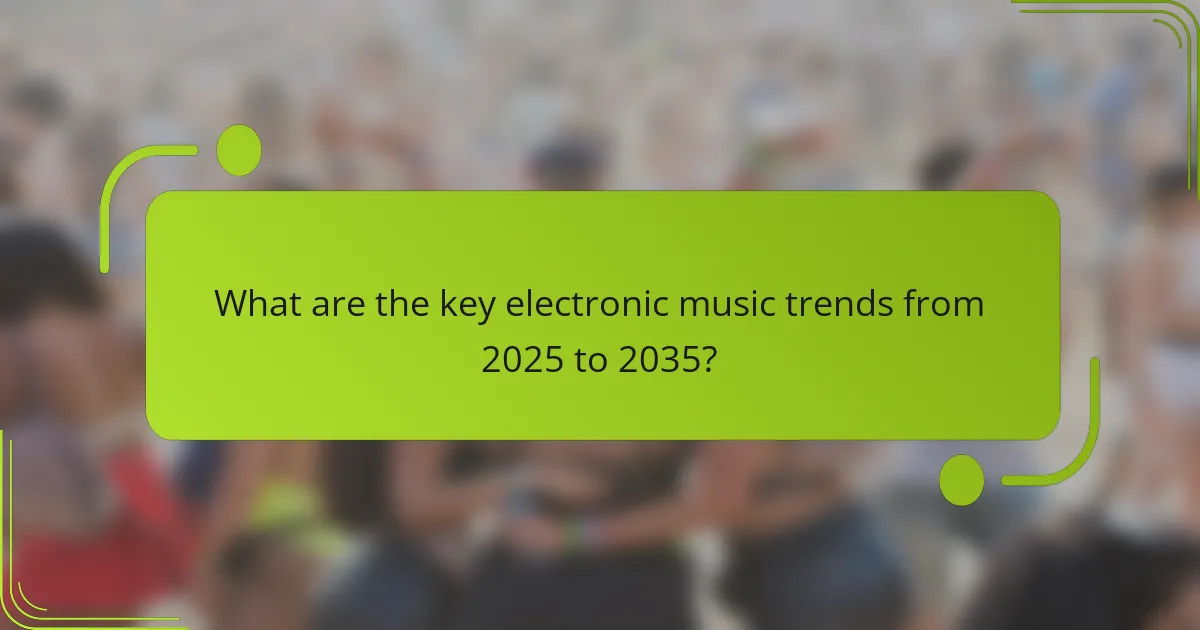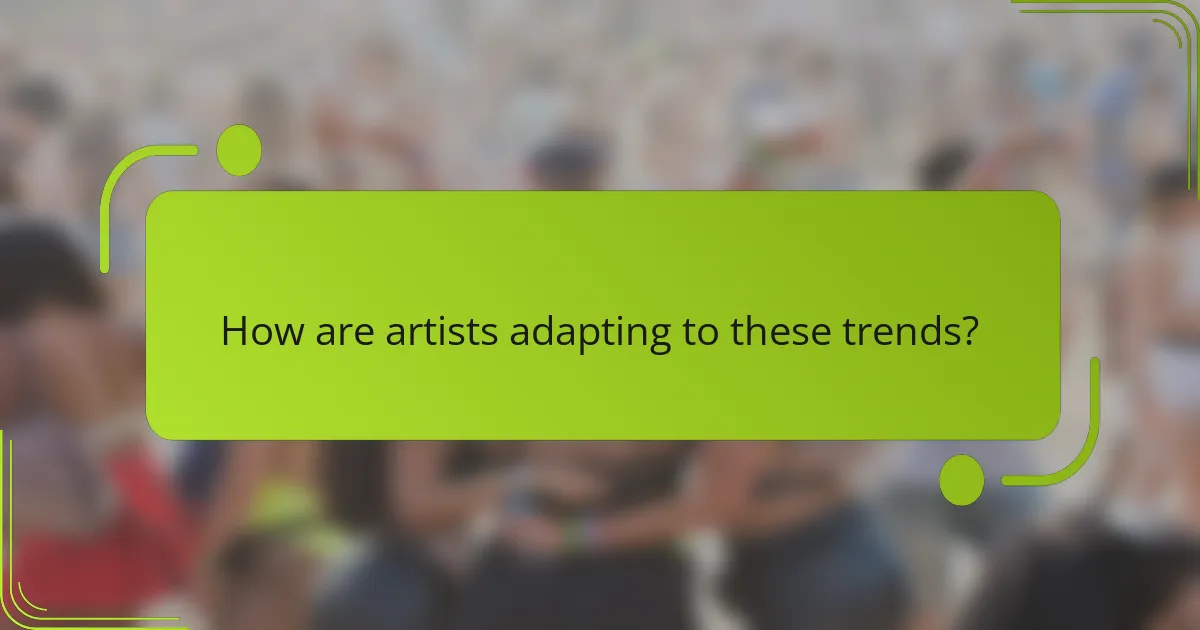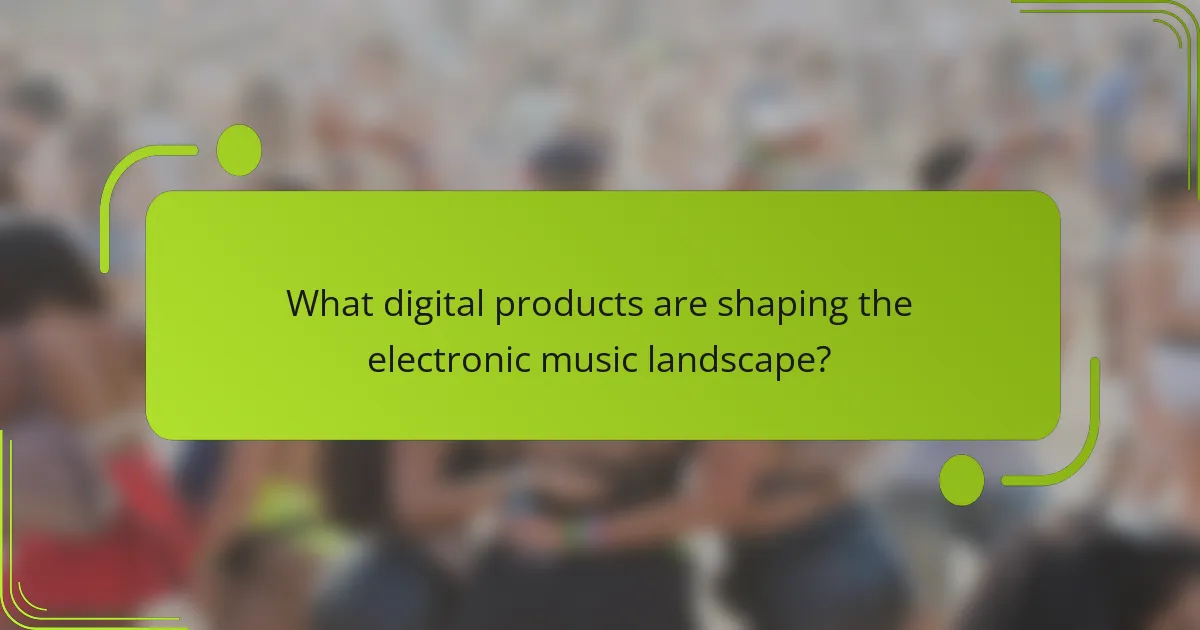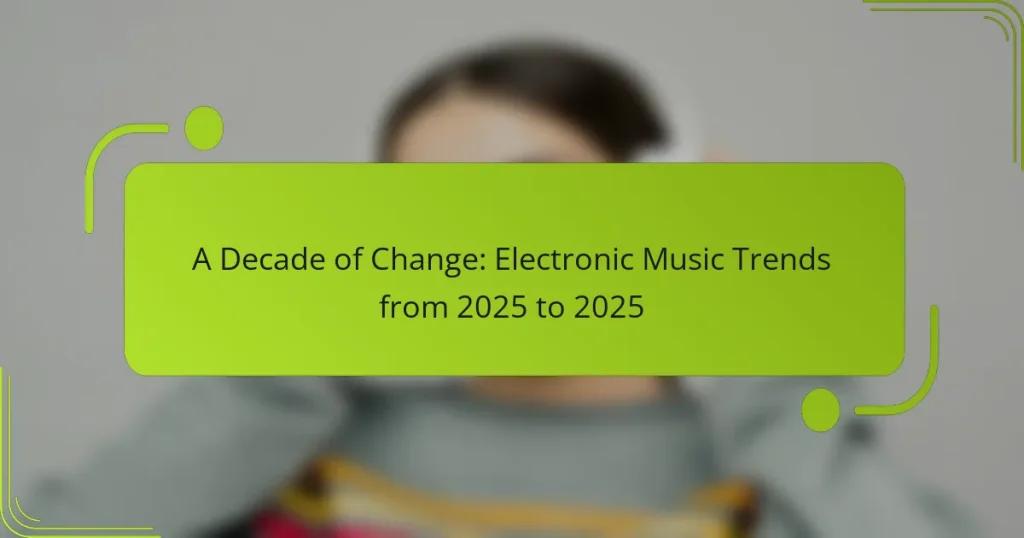Between 2025 and 2035, electronic music will undergo remarkable changes fueled by advancements in technology and shifting listener preferences. Emerging trends such as AI-generated compositions, virtual concerts, and blockchain integration will reshape how music is created, distributed, and experienced. Artists will leverage these innovations to connect with audiences in unprecedented ways, enhancing both creativity and engagement in the electronic music landscape.

What are the key electronic music trends from 2025 to 2035?
From 2025 to 2035, electronic music will experience significant transformations driven by technology and changing audience preferences. Key trends include the rise of AI-generated music, the popularity of virtual concerts, and the integration of blockchain in music distribution.
Rise of AI-generated music
AI-generated music is becoming a prominent trend, with algorithms capable of composing tracks that mimic various styles and genres. This technology allows artists to experiment with new sounds and ideas, often resulting in innovative music that may not have been possible through traditional methods.
Tools like OpenAI’s MuseNet and Google’s Magenta are examples of platforms that enable musicians to create AI-assisted compositions. Artists can use these tools to enhance their creative process, but they should be mindful of copyright issues and the implications of using AI in their work.
Increased popularity of virtual concerts
Virtual concerts have surged in popularity, especially following the global pandemic. These events allow artists to reach wider audiences without geographical limitations, often incorporating interactive elements that enhance viewer engagement.
Platforms like VRChat and Roblox are hosting immersive concerts, where fans can experience performances in virtual environments. Artists should consider the technical requirements and the need for high-quality streaming to ensure a successful virtual event.
Integration of blockchain in music distribution
Blockchain technology is revolutionizing music distribution by providing transparent and secure methods for artists to share their work. This system allows for direct transactions between creators and consumers, reducing the need for intermediaries.
Platforms like Audius and Ujo Music are leading the way in utilizing blockchain for music rights management and royalty distribution. Artists should explore these platforms to retain more control over their earnings and ensure fair compensation for their work.
Growth of immersive audio experiences
Immersive audio experiences, such as 3D sound and spatial audio, are becoming increasingly popular in electronic music. These technologies enhance the listening experience by creating a more engaging and realistic sound environment.
Services like Dolby Atmos and spatial audio formats are gaining traction, allowing producers to create tracks that envelop listeners. Artists should consider investing in these technologies to elevate their music and attract audiences seeking unique auditory experiences.
Emergence of genre-blending styles
The blending of genres is a defining characteristic of contemporary electronic music, leading to the emergence of hybrid styles that combine elements from various musical traditions. This trend reflects the diverse influences and cultural exchanges present in today’s music scene.
Artists are increasingly experimenting with fusions of electronic, hip-hop, pop, and world music, resulting in innovative sounds that appeal to a broad audience. Musicians should embrace this genre-blending approach to stay relevant and connect with listeners who appreciate diverse musical expressions.

How are artists adapting to these trends?
Artists are increasingly embracing new technologies and platforms to stay relevant in the evolving electronic music landscape. By integrating AI, virtual reality, and NFTs, they enhance their creative processes and engage with fans in innovative ways.
Utilizing AI tools for music production
AI tools are transforming music production by enabling artists to streamline their creative workflows. These technologies can assist in generating melodies, harmonies, and even entire tracks, allowing musicians to focus on refining their unique sound.
Popular AI software, such as Amper Music and AIVA, offers user-friendly interfaces that can help both seasoned producers and newcomers. Artists should consider experimenting with these tools to discover new sonic possibilities and enhance their production efficiency.
Engaging fans through virtual reality platforms
Virtual reality (VR) platforms are becoming essential for artists to create immersive experiences that captivate their audience. By hosting virtual concerts or interactive music videos, musicians can reach fans worldwide, breaking geographical barriers.
Platforms like Oculus Venues and VRChat allow artists to engage with fans in real-time, offering unique experiences that traditional concerts cannot match. Artists should explore these platforms to create memorable events and foster a deeper connection with their audience.
Leveraging NFTs for exclusive content
NFTs (non-fungible tokens) are revolutionizing how artists monetize their work by providing a way to sell exclusive digital content directly to fans. Musicians can offer limited edition tracks, artwork, or concert tickets, creating a sense of scarcity and value.
Using platforms like OpenSea or Rarible, artists can mint their NFTs and set their prices, often in cryptocurrency. However, they should be mindful of market trends and the environmental impact of blockchain technology when entering the NFT space.

What digital products are shaping the electronic music landscape?
Digital products like music production software, streaming platforms, and virtual reality concert experiences are significantly influencing the electronic music scene. These tools and services enhance creativity, accessibility, and audience engagement, making them essential for artists and fans alike.
Music production software like Ableton Live
Ableton Live is a leading music production software that allows artists to create, edit, and perform music in real-time. Its intuitive interface and powerful features make it suitable for both beginners and experienced producers. Key functionalities include session view for improvisation and arrangement view for structured composition.
Producers should consider the software’s compatibility with various plugins and hardware. Many users benefit from integrating MIDI controllers to enhance their workflow. Additionally, exploring tutorials and community forums can accelerate the learning curve and unlock advanced techniques.
Streaming platforms such as Spotify and SoundCloud
Streaming platforms like Spotify and SoundCloud play a crucial role in distributing electronic music to global audiences. These services allow artists to share their tracks easily and gain exposure without the need for traditional record labels. They also provide valuable analytics to help artists understand their listener demographics.
Artists should leverage playlists and collaborations to increase their visibility on these platforms. Engaging with listeners through social media and responding to comments can foster a loyal fanbase. However, it’s essential to be aware of the varying royalty rates across platforms, which can impact earnings.
Virtual reality concert experiences
Virtual reality (VR) concert experiences are transforming how fans engage with electronic music. These immersive environments allow users to attend live performances from the comfort of their homes, providing a unique way to experience music. VR concerts often feature interactive elements, enhancing audience participation.
Artists and event organizers should consider the technical requirements for hosting VR concerts, such as high-quality streaming and user-friendly interfaces. Collaborating with VR platforms can also expand reach and provide innovative ways to monetize performances. As technology evolves, staying updated on the latest VR trends will be crucial for maximizing audience engagement.

What are the challenges facing electronic music artists?
Electronic music artists face several challenges, including monetization, maintaining artistic integrity in the age of AI, and adapting to rapid technological advancements. These factors significantly impact their ability to thrive in a competitive and evolving industry.
Monetization in a digital-first world
In today’s digital landscape, electronic music artists must navigate various monetization strategies to sustain their careers. Streaming platforms, while offering exposure, often provide low payout rates, making it crucial for artists to diversify their income sources.
Common revenue streams include live performances, merchandise sales, and licensing music for media. Artists should consider building a strong online presence and engaging with fans through social media to enhance their monetization efforts.
Maintaining artistic integrity with AI
The rise of AI in music production presents both opportunities and challenges for electronic artists. While AI tools can enhance creativity and streamline workflows, they may also lead to concerns about authenticity and originality.
Artists should find a balance between leveraging AI technology and preserving their unique sound. Collaborating with AI can be beneficial, but it’s essential to ensure that the final product reflects the artist’s vision and style.
Adapting to rapid technological changes
Technological advancements in music production and distribution are occurring at an unprecedented pace, requiring electronic artists to stay informed and adaptable. New software, hardware, and platforms emerge regularly, which can enhance creativity but also demand continuous learning.
Artists should invest time in exploring new tools and techniques, attending workshops, and networking with peers. Embracing change and being open to experimentation can help artists remain relevant and innovative in a fast-evolving industry.

How is the audience’s role evolving in electronic music?
The audience’s role in electronic music is becoming increasingly interactive and influential. With advancements in technology and social media, fans are not just passive listeners but active participants in shaping the music experience.
Increased Interactivity
Modern electronic music events often incorporate interactive elements, allowing audiences to engage directly with the performance. For example, live voting apps enable fans to choose the next track or remix, creating a dynamic atmosphere. This shift encourages a sense of community and shared experience among attendees.
Social Media Influence
Social media platforms have transformed how audiences interact with electronic music. Fans can share their favorite tracks, create playlists, and even promote emerging artists, significantly impacting their popularity. Artists often rely on social media feedback to refine their sound and connect with their audience more authentically.
Collaborative Creation
Collaboration between artists and fans is becoming more common, with initiatives like crowd-sourced music projects gaining traction. Fans can contribute ideas, samples, or even lyrics, resulting in a more personalized and collective creation process. This trend not only empowers listeners but also fosters a deeper connection to the music.


